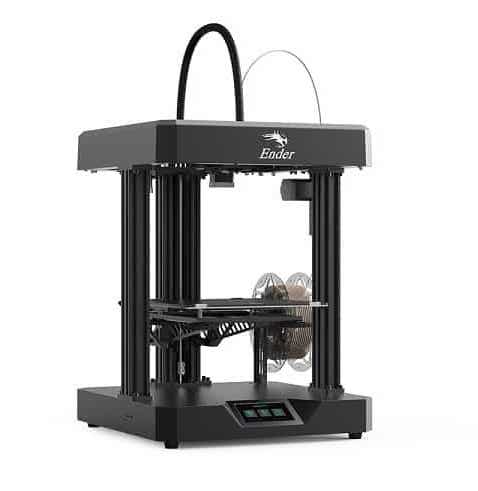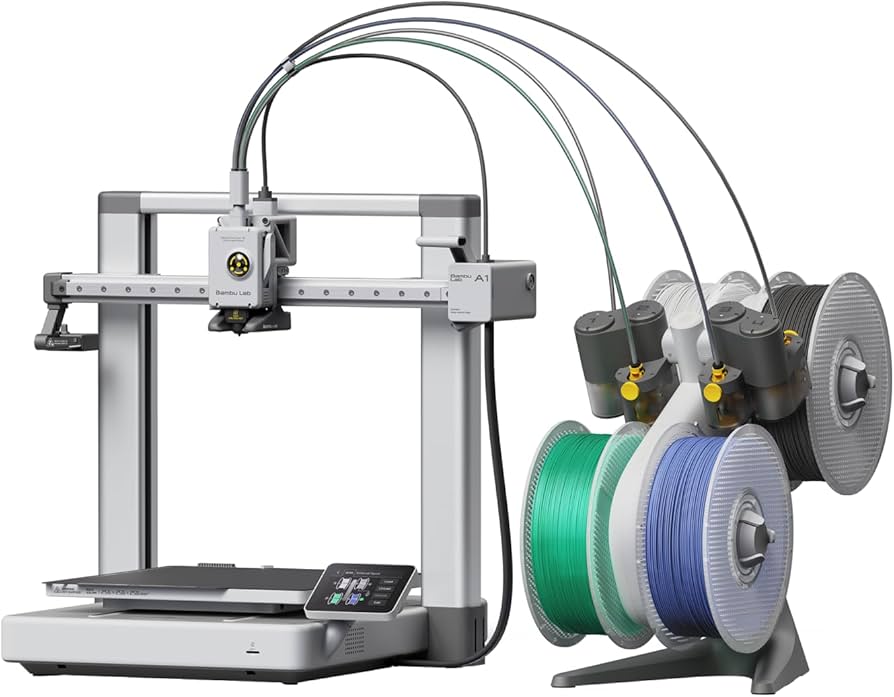Compare Ender 7 vs A1
Comparison between the best 3D printers
Choose the best 3D printer at the best price. The cheapest 3D printers are here.
Buy a 3D printer here with 3D Fila.
 |
 |
|
| Model | Ender 7[BUY Ender 7] |
A1[BUY A1] |
| Printing Material | Filament | Filament |
| Buy Filament for Creality 3D Ender 7 | Buy Filament forBambu Lab A1 | |
| Estimated price | $429,00 | $700,00 |
| Manufacturer | Creality 3D | Bambu Lab |
| Release Year | 2021 | 2023 |
| Print Volume [mm] | 250x250x300 | 256x256x256 |
| Printer Size [mm] | 430x460x570 | 385x410x430 |
| Weight [kg] | 17,2 | 8,3 |
| Power Loss Recovery | YES | YES |
| Enclosed printer | NO | NO |
| Bed Leveling | Manual | Automatic |
| Filament End Sensor | YES | YES |
| Bed type | Heated | Heated |
| Power supply system | Bowden | Direct Drive |
| Standard nozzle | 0,4 | 0,4 |
| Maximum Nozzle Temperature [°C] | 260 | 300 |
| Maximum Bed Temperature [°C] | 100 | 100 |
| Maximum printing speed [mm/s] | 250 | 500 |
| Filament holder | YES | YES |
| Camera for supervision | NO | NO |
| Recommended filaments | PLA, PETG, Tritan, Flex, ABS | PLA, PETG, TPU, PVA |
| Recommended slicers | Cura, Simplify, Slic3r, IdeaMaker | SuperSlicer, PrusaSlicer, Cura, OrcaSlicer |
| Maximum Resolution [mm] | 0,1 | 0,1 |
| Processor | Creality CR-FDM V.2.4.S1_V101 32bits | |
| Display | Display touchscreen 4,3'' | Touchscreen 3,5 |
| Power Supply | 110/220V / 350W | 350 W |
| Connectivity | SD / USB | Wi-Fi, Bambu-Bus, Cartão Micro SD |
| Operating systems | Windows, Mac, Linux | Windows, Linux, Macbook |
| Date of registration in the system | 2022-11-04 | 2024-07-17 |
| Release date | 2021 | 2023 |
| Extra features | Crealitys Ender 7 printer offers remarkable print speeds, utilizing CoreXY kinematics for precise and fast movement. With a 250x250x300mm build area, dual direct extruder, and custom hotend, the Ender 7 is capable of printing at high speeds, although quality may suffer on smaller prints. Assembly is relatively straightforward, but the machine is noisy and can get hot. Its true speed potential is most noticeable on larger prints, where it outperforms its competitors. | The BambuLab A1 printer features fully automatic calibration, multi-color printing with the AMS system, active flow rate compensation, quick nozzle change with a clip, active motor noise cancellation, a build volume of 256x256x256 mm³, a maximum extruder temperature of 300°C, and a heated bed of up to 100°C. In addition, it has high precision, a machine health management system and an intuitive 3.5-inch touchscreen interface. |
| Support for multiple colors and materials (AMS and CFS) | NO | YES |
Notes * |
||
| Cost-benefit | 7 / 10 | 7 / 10 |
| Hardware | 2 / 10 | 4.2 / 10 |
| Tela | . | . |
| Print volume | 4 / 10 | 4 / 10 |
| Performance | 2 / 10 | 4 / 10 |
| [BUY Ender 7] | [BUY A1] |
Conclusion |
| In comparing the Creality 3D Ender 7 and the Bambu Lab A1 3D printers, several key aspects emerge that can aid in making an informed decision based on user needs and budget considerations. The **Creality 3D Ender 7** is a more budget-friendly option with a solid performance primarily built for speed. It features a larger build area and is ideal for users who prioritize high-volume prints without much detail. However, it does require manual bed leveling and may produce noise during operation, indicating that it might not be the best choice for those seeking a quieter environment. Additionally, its hardware and overall versatility receive lower ratings compared to its competitor. On the other hand, the **Bambu Lab A1** presents a more advanced option with features like automatic calibration and support for a wider array of materials, making it suitable for more complex printing tasks. Its higher price reflects its enhanced capabilities such as active flow compensation and noise cancellation. This model is particularly appealing to users looking for precision and ease of use, especially in a professional setting. In conclusion, if budget constraints are a significant factor, the Creality 3D Ender 7 provides good value for high-speed printing with acceptable performance for simpler projects. Conversely, if one is willing to invest more for advanced features, including ease of use, precision, and versatility in material handling, the Bambu Lab A1 stands out as a superior choice. Ultimately, the decision should be based on specific printing needs and the intended use of the 3D printer. |

